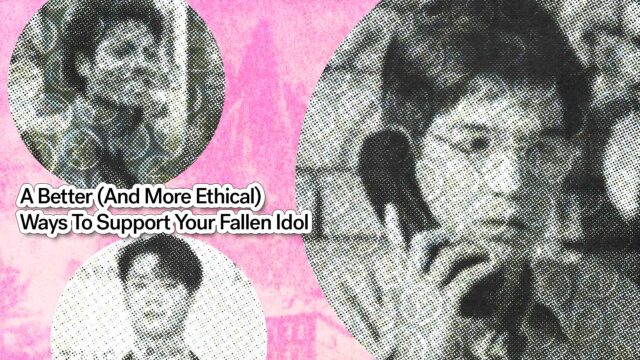Who would have thought that a case of media censorship at the University of Santo Tomas would start with Type B uniforms and a convenience store selling Slurpees?
Related: Org Spotlight: On Kythe-Ateneo’s Meaningful, Hope-Giving Service
Apart from mango shakes in Dapitan and street food around campus, certified Thomasians typically live for two things during the scorching summer: strolls to 7-Eleven for a pocket-friendly Slurpee and Type B uniforms. Although seemingly small aspects of the day-to-day life of college students, the combination of these two has recently made headlines.
With just a casual scroll through X (formerly Twitter,) you’ll find the go-to convenience store being tied to what people are saying a case of media censorship. Intrigued about what links a candid photo of College of Information and Computing Sciences (CICS) students chilling outside 7-Eleven to the trending #DefendPressFreedom? Here’s the lowdown on why the University of Santo Tomas is under fire for what could’ve been a mere summer snapshot.
A Fine Line Between Humor and Humiliation

Summer season means it’s time for the Type B uniform at the University of Santo Tomas, an alternative and more comfortable attire ~mandated~ to be worn by students until the term concludes in May.
To celebrate this small win, as many students prefer this setup, TomasinoWeb took photos of students wearing their Type B uniforms and posted them on social media. Among the sea of snapshots, it was the College of Information and Computing Sciences (CICS) students who stole the spotlight with their uniform’s uncanny resemblance to the attire of 7-Eleven employees.

Much to the amusement of outsiders and Thomasians, these CICS students found themselves immortalized in cyberspace as they made their way into the convenience store. Little did they know, this moment of lightheartedness would soon turn into a debacle in the eyes of UST’s Office for Student Affairs (OSA), who interpreted the candid campus photo as nothing short of public mockery. After all, there’s a fine line between humor and humiliation.
Campus Life and Media Censorship
READ: The official statement of TomasinoWeb regarding the Photograph of CICS students wearing their Type B uniform. pic.twitter.com/TjCxR0R7bx
— TomasinoWeb (@TomasinoWeb) February 16, 2024
The photograph surfaced on February 15, sparking curiosity when it mysteriously disappeared the following day. As the dust settled, TomasinoWeb shed light on the situation later in the evening, and the plot thickened.
It turns out, some eagle-eyed members of OSA weren’t exactly fans of the photo. They raised “concerns,” deeming the image a “source of public ridicule” due to the supposed resemblance of the CICS Type B color palette to the attire of 7-Eleven employees.
In response to the issue, TomasinoWeb released a statement, stating, “To rectify this, we have removed the photograph from the album across all our social media platforms,” emphasizing that their intention had always been lighthearted and harmless. Nevertheless, to appease the situation, they made the executive decision to pull the controversial photo from the album across all their social media platforms.
'NATAPAKAN 'YUNG PAGKA-JOURNALIST KO'
— The Flame (@abtheflame) February 19, 2024
WATCH: Former TomasinoWeb adviser Leo Laparan II talks about the takedown of the photo of two information and communication technology students that raised concerns from some UST administrators. pic.twitter.com/vZhAmDtgJ2
In the wake of the controversy, TomasinoWeb’s adviser, Leo Laparan, made the difficult decision to resign from his post on February 19. Having served as the publication adviser for over a year, the respected instructor faced the challenging aftermath of the photo incident. In an interview with The Flame, the official student publication of the UST Faculty of Arts and Letters, Leo expressed the publication’s stance, asserting their decision to stand by the photo.
Disheartened by the situation, he stated, “We could not do anything; I felt my being an adviser (was) irrelevant.” He went on to characterize the incident as an example of media censorship, emphasizing, “That is a glaring illustration of censorship because there’s nothing wrong with the photo.”
Press Freedom? We Don’t Know Her

Since then, social media has witnessed an uproar with the powerful hashtags #DefendTomasinoWeb and #StandWithTomasinoWeb. This rallying cry goes beyond defending a university publication; it stands as a collective assertion in safeguarding the core tenets of press freedom.
The discourse highlights a broader concern about media censorship, and the stakes are even higher when we consider that these digital spaces are the training grounds for the future journalists of our country. Especially when we continuously fight for journalists in the Philippines, these trusted universities should be on our side, providing a space where we can freely share our opinions, perspectives, and intellectual work—an environment that will shape the ethical and professional standards of the next generation of media practitioners, empowering them with the ability to influence and inspire positive change.
Continue Reading: Here’s How to Romanticize Your Life as a ~Broke~ College Kid





